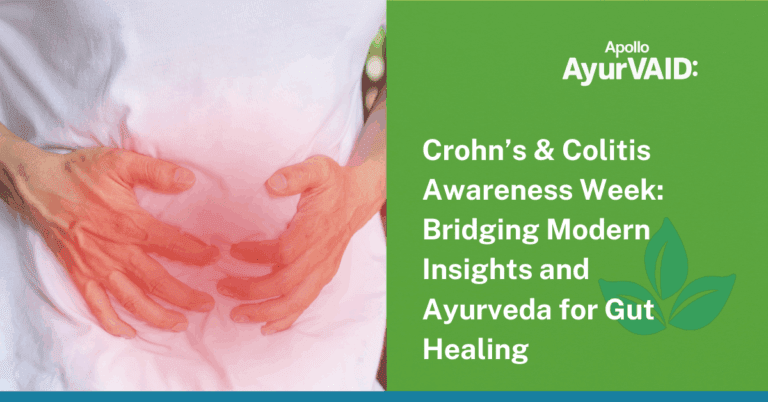Introduction
Neuropathy refers to any condition that causes nerve damage or dysfunction, with symptoms like numbness, tingling, burning sensations, or pain. It affects peripheral nerves, usually beginning in the hands and feet. It can happen due to several reasons, including diabetes, medications, injuries, infections, vitamin deficiencies, and autoimmune disorders. Early diagnosis is vital since neuropathy can worsen over time. Treatment generally involves managing symptoms and the underlying causes.
In this blog, we will explore how Ayurveda provides a natural and comprehensive approach to managing neuropathy and its underlying causes. The treatment modalities promote overall health and well-being, potentially helping patients to improve their quality of life.

Neuropathy in Ayurveda Perspective
Ayurveda addresses neuropathy, particularly diabetic peripheral neuropathy (DPN), by tackling symptoms along with managing the root cause. Neuropathy is often associated with ‘Vata’ and ‘Kapha’ imbalance, especially affecting the nervous system. A disturbance in the body’s natural energy flow (Vata dosha) due to obstruction caused by Kapha dosha leads to neuropathy, which requires both systemic and targeted local treatment. Conditions like DPN are considered as Prameha Upadrava (diabetic complications), in which burning sensation and numbness are considered as a sign of nerve dysfunction and treated accordingly along with managing the root cause, i.e., diabetes.
Ayurvedic Treatments for Neuropathy
The purpose of Ayurveda treatment for neuropathy is to reduce the symptoms (such as pain, numbness, and tingling), delay progression, and improve the quality of life of the patients. It is done with the help of a combination of Ayurveda therapies, dietary management, and internal medications to restore the balance in the body and treat neuropathy, which is due to diabetes.
Specific Ayurveda medications, Panchakarma therapies, and local therapies such as Kaya Seka, Abhyanga, Swedana, etc., are incorporated after assessing the condition of the patient and the stage of the disease. These modalities are proven to have marked improvement of the neuropathy symptoms, thus being beneficial in DPN management.
Ayurveda Treatment Outcomes:
- Symptom Relief: Reduction of symptoms like tingling, numbness, and pain
- Disease Management: Prevent the progression and manage the root cause of neuropathy such as diabetes.
- Restoration of Function: Improvements in nerve function and sensation
- Delay Progression: Delay the disease progression and prevent further complications.
Ayurveda for Diabetic Neuropathy
Diabetic neuropathy is nerve damage that occurs in people with diabetes, which affects nerves all over the body, usually in the feet and legs, and then spreads to other parts of the body. Common signs may include numbness, tingling, burning sensations, and muscle weakness, which can become sufficiently severe to cause mild discomfort, or even significant pain, and disability. If not treated, complications include foot ulcers, infections, and amputation. It can also affect other bodily functions and quality of life.
Diabetic neuropathy can be prevented or controlled by proper diabetes management with Panchakarma, medication, diet, and lifestyle changes. Medications that improve nerve conduction, decrease pain, and reduce the blood sugar level are prescribed. Abhyanga, udvartana, and vasti (enema), etc., modalities are also incorporated in relieving symptoms after assessing the condition of the patient and the stage of the disease. The Ayurveda treatment approach is aimed at symptom cure and systemic balance with the ultimate goal of root cause reversal.

Ayurvedic Treatment for Neuropathic Pain
Ayurveda focuses on reversing neuropathy symptoms and bringing back the neurons to their original structure. The following treatment modalities are utilised to reduce the pain, mitigate aggravated Vata, and prevent further progression.
- Panchakarma procedures like Vasti, Vamana, and Virechana to balance Vata and Kapha dosha involved in the pathogenesis
- Murdha Taila is a set of four oil-based treatments (overhead region) in Ayurveda. Shiroabhyanga (oil therapy on the head), Shirodhara (continuous oil streaming on the forehead), Shirobasti (oil retention on the head), and Shiropichu (medicated oil application over bregma) are these treatments. They are designed to nourish the nervous system, improve communication, reduce inflammation, increase circulation, and slow neurological deterioration.
- Local treatments such as Abhyanga (oil therapy), Swedana (steam therapy), Lepam (paste applications), Pichu (warm medicated oil application), Kizhi (herbal poultice), etc., are also adopted to stimulate nerve endings and increase neurotransmitter activities.
Conclusion
Ayurvedic therapies for neuropathy stand out because we tackle the condition beyond the symptoms. The treatment is focused on balancing the body’s fundamental doshas (Vata and Kapha) and the actual root cause. The treatment modalities offer comprehensive healing and nerve regeneration support. As Ayurveda focuses on personalised treatment plans, based on the body’s constitution, every patient is given targeted treatment for the best results. More importantly, the combination of dietary modifications, yoga, and stress management techniques with medicinal treatments provides a healing environment that is sustainable and supports long-term nervous system health and overall well-being.
References
- Parveen, R, Baruah, H (2019). An ayurvedic approach to the diagnosis and management of diabetic neuropathy. AYUHOM, 6, 53 – 59. https://doi.org/10.4103/AYUHOM.AYUHOM_3_21
- Ravindran, V, Binitha, A (2024). Udgharshana (an Ayurvedic therapeutic intervention) in improving vibration perception threshold in diabetic distal symmetric polyneuropathy: An observation. Journal of Ayurveda Case Reports, 7, 16 – 21. https://doi.org/10.4103/jacr.jacr_23_23
- D, A et al. (2024). A Case Report on the Ayurvedic Management of Diabetic Peripheral Neuropathy. International Journal of Ayurveda and Pharma Research. https://doi.org/10.47070/ijapr.v12i7.3325
- Sahebrao, S et al. (2023). Sahacharadi Yapan Basti a silver bullet in ayurvedic management of diabetic peripheral neuropathy- a case study. World Journal of Advanced Research and Reviews. https://doi.org/10.30574/wjarr.2023.18.1.0620
S, L P et al. (2024). - Ayurvedic Treatment Modalities of Diabetic Peripheral Neuropathy. International Journal of Ayurveda and Pharma Research. https://doi.org/10.47070/ijapr.v12i3.3177






